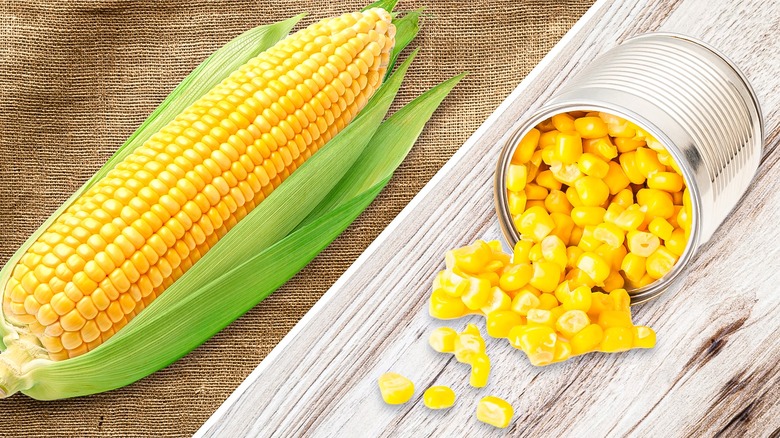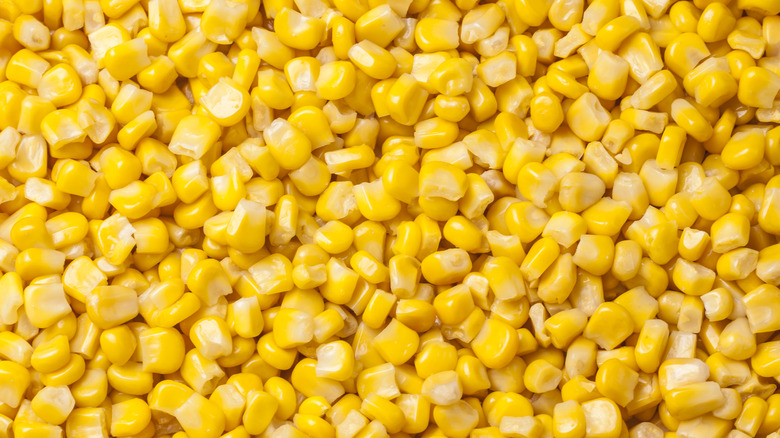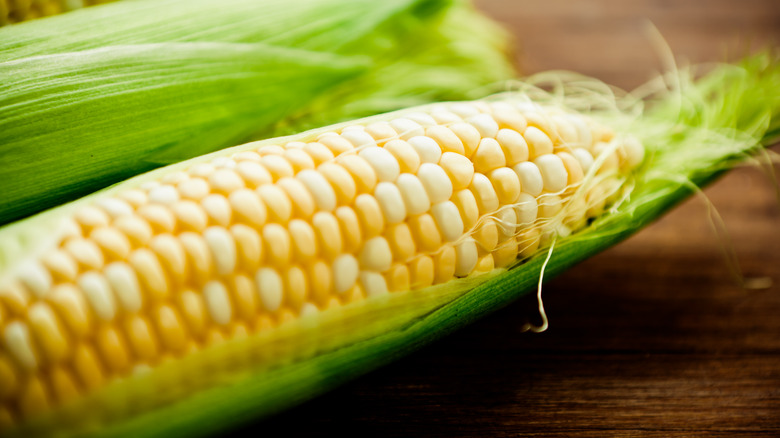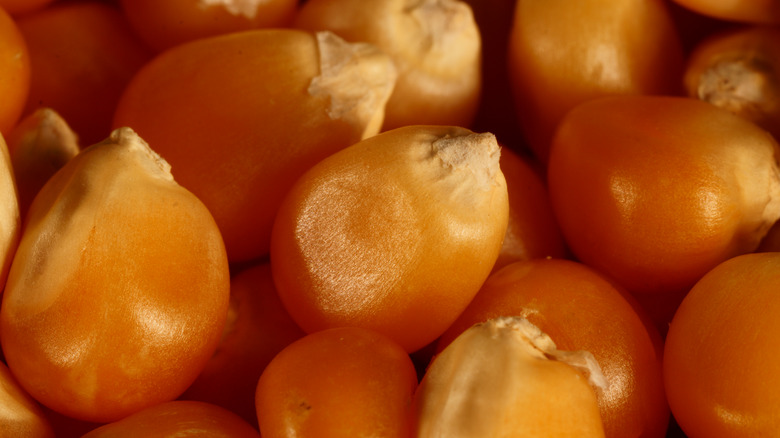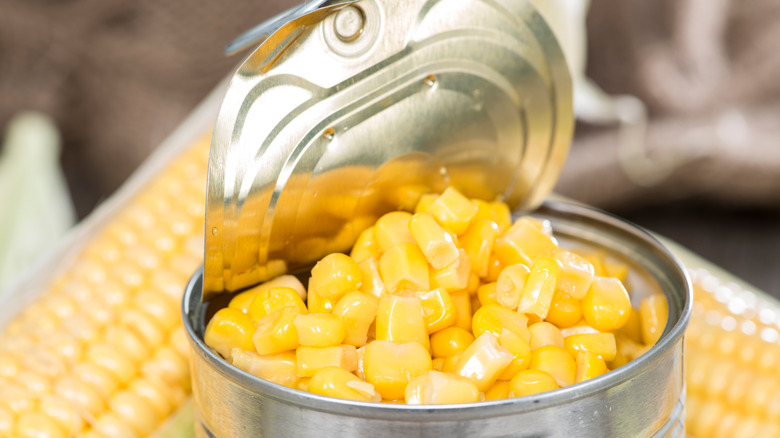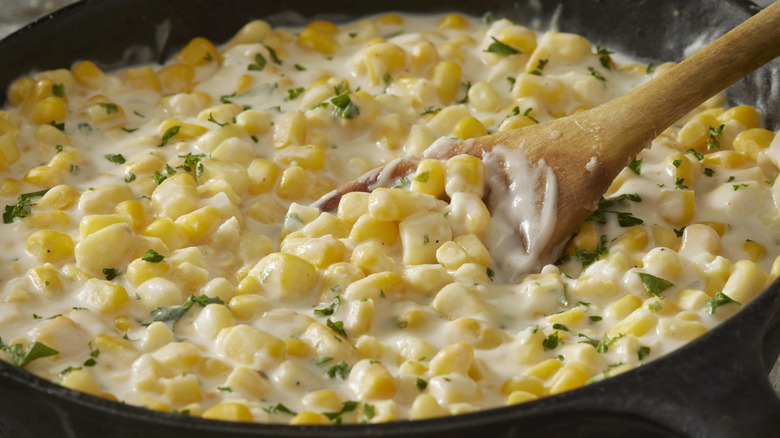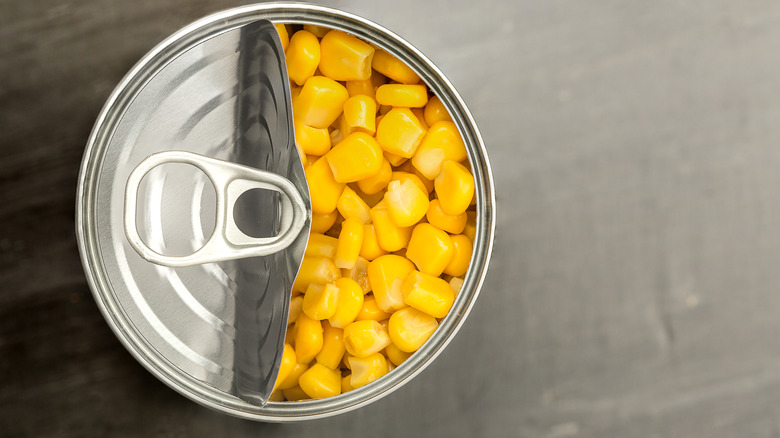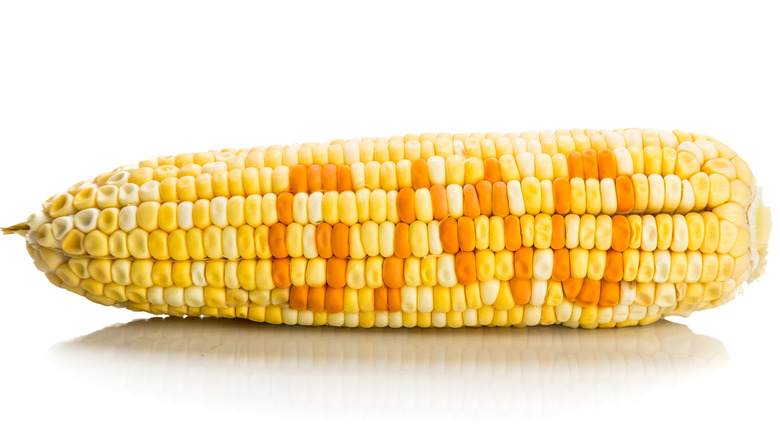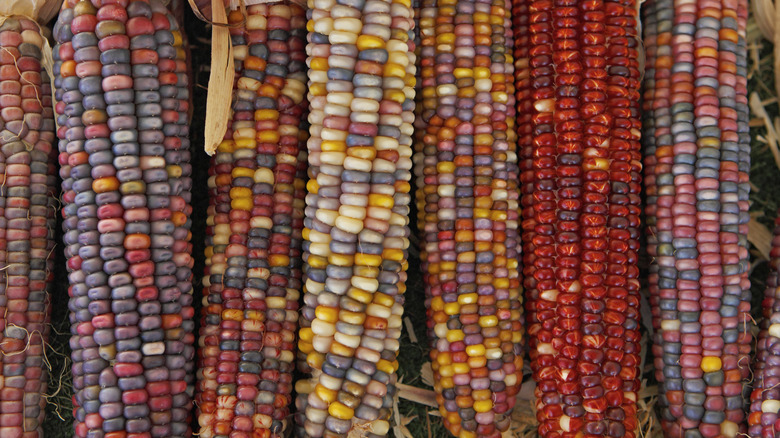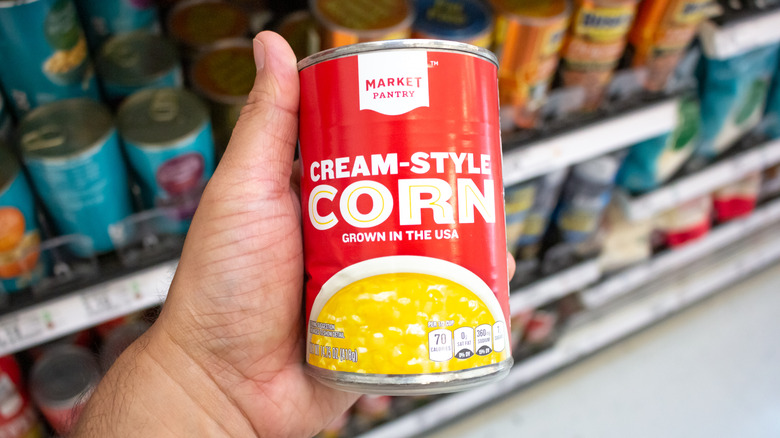Canned Corn Vs Fresh Corn: Everything You Need To Know
Corn is a beloved summer staple, found at many a roadside stand. A versatile vegetable, corn lends itself well to a variety of preparations ranging from simple to more technical. When in season, there's perhaps no recipe more rewarding than simply boiling or grilling it, and serving it with butter and salt. But corn is also delicious when rolled in mayo, cheese, and seasonings as for Mexican street food staple elote. In Japan, it's often glazed in miso or soy, while in South America, it may be served raw in fresh salads. Corn can also be cooked into fritters, soups, or cornbread. And that's just the beginning.
American corn is grown chiefly in the Midwest, specifically in Iowa, Illinois, and Nebraska, the three top producers in the U.S. But much of the production in these states is of a variety of corn that wouldn't be quite so welcome in the recipes cited above. Indeed, sweet corn stands out as one of six major kinds of corn. Dent corn is used to make processed corn products like corn chips, while flint corn is known for its beautiful colors. Popping corn is a variety of flint corn with a hard outer shell that pops when steam builds up inside. Flour corn is softer and starchier, perfect for making flour. If you're a sweetcorn fan, you may have faced off with the decision: fresh or canned? The answer depends on many factors stemming from the myriad differences between fresh and canned corn.
Canned corn is already cooked
There are loads of different ways to cook fresh corn from frying to grilling — and some even eschew cooking it altogether, enjoying it instead in fresh corn salads or salsas. But canned corn, by definition, can never be served raw since it's already been cooked by the canning process. While this makes it a breeze to serve up in Mexican street corn salad esquite or for stirring into a quick pasta salad straight out of the can, it also means canned corn can be easy to overcook. Indeed, heat it for just a minute too long, and you risk rendering it tough and chewy — far from the crisp, toothsome texture we know and love. This is why most experts recommend that if you're cooking with canned corn, you just need to barely heat it through before serving it.
But overcooking isn't a problem unique to canned corn. As corn cooks, the sugars convert to starches, meaning the longer it hangs out on the heat, the starchier (and less sweet) it will become. Three to five minutes at a boil is enough to cook your corn through; on the grill, 15 to 20 minutes is perfect. You can even microwave corn for just four minutes to cook it through until it's perfectly sweet.
Fresh corn has a short season
There's a reason we associate corn on the cob with summertime: It's most bountiful — and most delicious — in the summer months. Depending on where you live, corn season may begin as early as May and last until October, but by and large, it's a crop that's at its best in late summer. Eaten outside of its peak, it will likely be starchy and not nearly as sweet as one might hope ... or you might not be able to find it at the store at all. And that's where the benefits of canned corn come in.
By definition, canned corn has no season; indeed, like other canned goods, its shelf-stable nature means it's available any time of year — ready to be used in warmer dishes that might not be as welcome in the summer heat, such as corn pudding or rich and creamy corn pasta. It's no wonder that so many home gardeners reap the season's bounty and can their own! But if your thumb isn't green enough to grow your own corn and you're craving the sweet kernels in December, a can of corn from the grocery store is the ideal way to dig in.
Canned corn has its tip caps removed
When you eat corn on the cob, you'll notice that at the base of each kernel, there's a hard, starchy part that is attached to the cob. (You might be familiar with it from trying to extract it from your teeth after indulging!) This part of the corn kernel is called the tip cap; it's the part that absorbs nutrients from the cob, essentially feeding each kernel. The tip cap itself is mostly made up of fiber, as opposed to the rest of the kernel. The corn kernel itself is made up of the endosperm (made up mainly of starch and protein), and the pericarp (which covers the kernel, preserves its nutrients, and is also made from fiber). The germ inside, meanwhile, is where the fat in corn comes from and is comprised of 25 percent corn oil.
While kernels of corn in a can retain their endosperm, pericarp, and germ, before canning, the tip caps are removed, which means the final product contains slightly less fiber than fresh. It also means that you have a slightly less fibrous texture at the base, which may be more pleasant for some — especially those who are tired of contending with dental floss every time they eat corn.
Canned corn may contain other ingredients
While in some cases, canned corn contains exactly the ingredients it says on the label, more often than not, there are other elements added to the can. This includes not just the liquid in the can, which is usually a combination of water and some of the creamy juice from the corn kernels, but also any number of potential ingredients permitted by federal regulations. This includes but is not limited to flavoring agents like salt, MSG, and sugar, and additives that may increase shelf life or improve freshness or texture, such as citric acid or vegetable protein (via Code of Federal Regulations).
This laundry list of additives only holds true for "plain" corn. There are loads of brands that offer flavored or seasoned canned corn which may contain mint, lemon juice, spices, butter, or even red and green peppers. (By law, the latter two can't comprise more than 3 percent by weight, in the case of butter, or 15 percent by weight, in the case of peppers.) These seasoned corns can be helpful for those trying to get dinner on the table without too much extra work, but for those seeking to avoid additives, it's important to take a look at the ingredients list and inform yourself about what's actually going into that can of corn. When it comes to fresh corn, however, there's no added work to be done: All you'll find within the husk is fresh corn, pure and simple.
Canned corn may be creamed
In addition to potentially containing added seasonings and flavorings, canned corn might also be creamed. Cream corn, cream-style corn, and creamed corn are all different ways of referring to the same process, and despite its name, it actually has nothing to do with adding cream. Traditionally, creamed corn gets its creamy texture in the simplest of ways: by combining the fresh corn kernels with the milky liquid scraped right from the cob. With canned iterations, the corn itself is "creamed" (read: blended) until it takes on the sought-after creamy texture. When making creamed corn at home, you'll usually blend it by about half, often using a stick blender, so that you retain the ideal blend of textures.
Of course, if you want to gild the lily, you can certainly add cream, butter, or a combination of the two to make your creamed corn even creamier. Some folks also like to thicken up creamed corn with starches like cornstarch or rice flour, creamy cheeses like cream cheese, or even homemade béchamel sauce for even more richness. You can also jazz up your creamed corn — whether homemade or straight from the can — with other ingredients like cheese or herbs. These simple additions will transform creamed corn into an even more flavorful side dish.
Canned corn may have a duller flavor than fresh corn
Do a quick Google search for canned corn, and don't be surprised if many of the top results are concerned with how to make it taste better. There's no getting around it: Canned corn can taste duller and vary widely in texture as compared to the fresh stuff, with some brands eluding that crisp, toothsome texture so that the resulting corn is mushy, starchy, and far from as full of flavor as fresh. This has to do in part with the way in which it's processed: Since cooking corn transforms its sugars into starches, it dims its flavor. And seeing as canned corn is sitting, tip-cap-less, in a pool of liquid, it's no wonder it can lose some of its crispness.
Of course, this isn't the case for all brands. Some canned corn manages to taste just as good as those nostalgic summer cobs. And should you ever find yourself disappointed by its flavor, there are loads of ingredients to add to canned corn to jazz it up, from soy sauce to bacon grease, and butter to garlic. It may take a bit of added work in the kitchen, but by opting for the best-quality canned corn and taking advantage of just a few added seasonings, you'll soon have canned corn that tastes as good (or nearly!) as the farm-fresh stuff from a summer roadside stand.
GMO canned corn is easier to identify than GMO fresh corn
Corn is one of the most genetically modified crops in the U.S., with an estimated 93% of American cornfields being planted with GMO seeds. While genetic modification isn't dangerous in and of itself, GMO corn seeds are developed to withstand certain dangerous pesticides and herbicides like glyphosate, the active ingredient in Roundup. Buying this corn contributes to an added presence of these dangerous chemicals in our waterways — and even increases the risk that your corn itself will be contaminated with chemicals that are proven endocrine disruptors.
But just because there's a lot of genetically modified corn out there doesn't mean that most corn in the grocery store — or on your farmstand — is derived from genetically modified seeds. Most GMO corn is of the field corn variety; there's no GMO popcorn available on the market, and while Bayer (formerly Monsanto) does produce genetically modified sweet corn, only an estimated 10 to 25% of American sweet corn is likely to be genetically modified.
If you're looking to avoid GMO corn, however, it's going to be far easier if you're buying it in a can, seeing as labels like Non-GMO Project approved guarantee that the product you're buying was not grown with genetically modified seeds. If you want to be 100% certain that your fresh corn is non-GMO, opt for organic: USDA Certified Organic foods are required to be devoid of genetically modified ingredients.
Canned corn is a better value than fresh corn
In the height of summer, fresh corn may seem cheaper than canned, when it pops up for something around a dollar an ear. But canned corn is still a better value than fresh. The reason comes down to the way it's processed: Fresh corn has a lot of waste material attached to it, from the leaves to the silk to the cob. This reduces the total volume of the food you can actually consume — and what's more, removing it demands hands-on labor and time.
Researchers took the cost of the waste plus the prep time into account in making their calculations, finding that buying canned corn is a 25% better value over fresh. These findings were confirmed by another study from the USDA, which found that fresh corn costs about $1.17 per cup as compared to $.69 per cup for canned. These findings only further cement canned corn's status as the better value product.
Canned corn is healthier than fresh corn
For the most part, canned corn and fresh corn boast the same nutritional benefits. Rich in fiber, sweet corn also contains nearly all of the B vitamins, which are essential for brain function and range from folate to niacin, riboflavin to thiamine. Corn is also rich in antioxidants like vitamin C and minerals like phosphorus and magnesium (via Livestrong).
If you opt for plain canned corn, the nutritional differences between canned and fresh are minimal. Canned corn does contain more sodium than fresh, but other than that, it's actually slightly better for you, according to researchers at Cornell University, who in 2002 noted that the heat processing used to preserve the vegetable raised the levels of certain antioxidants and phenols. These compounds boast loads of health benefits, including reducing the effects of free radicals on the body and thus contributing to a lower risk of diseases like cancer (via Mayo Clinic). So, if the health benefits of corn are your primary concern, it's best to reach for a can rather than an ear.
There's more variety of fresh corn than canned
Flint corn, dent corn, and flour corn aside, there are a phenomenal number of varieties within the sweet corn category alone. Aside from the yellow, white, and bicolor categories you'll find in many markets, hybrid corn varieties like Ambrosia hybrid, known for its sweet flavor, or Nirvana hybrid that's known for its beautiful white-and-yellow kernels and high yield. There are even fresh heirloom corn varieties that boast some of the beautiful, bright colors you might know from flint corn, like Blue Hopi, with its gorgeous blue color, or Ruby Queen, which boasts a gorgeous deep red hue and sweet, tender kernels. Both of these varieties, unlike the dried corn you may find used decoratively, can be consumed fresh and may be found at some farmer's markets or can be grown at home.
But when it comes to canned corn, there just aren't that many choices. The USDA recognizes golden, white, or a combination of kernels in canned corn products. These can either be processed using conventional or supersweet methods, the latter of which will result in corn with a higher natural sugar content or a crisper taste. But if you want canned blue corn or a specific variety, you'll need to source, grow, and can it yourself.
Canned corn lasts longer than fresh corn
There are certainly ways that you can store fresh corn so that it keeps for longer. Keeping the husk on will prevent it from drying out, while storing it in a sealed plastic bag in the crisper drawer will extend its shelf life significantly. But the reality is that corn is best eaten the day it's picked, and even if you do your best to lengthen its shelf life, it can really only happily be kept for a maximum of a week. Any more than that and it will start to become starchy and far less sweet.
Canned corn, on the other hand, has a long shelf life, with a best-by date that may be three to five years after packaging. And even if the best-by date has passed, canned corn can probably be eaten long after the fact, Sofia Norton, R.D., a registered dietitian at Kiss My Keto, tells Eat This, Not That. Even the USDA says that canned goods can last for years as long as the can itself shows no signs of rusting, denting, or swelling. What this means, of course, is that canned corn has an exponentially longer shelf life than fresh, making it the perfect staple to keep on hand should the craving for corn suddenly arise.
